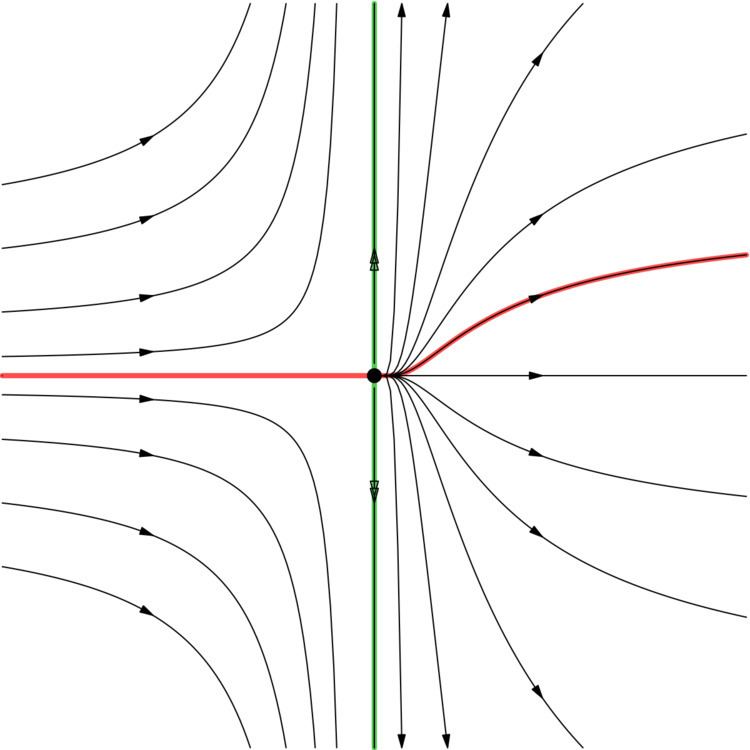 | ||
In mathematics, the center manifold of an equilibrium point of a dynamical system consists of orbits whose behavior around the equilibrium point is not controlled by either the attraction of the stable manifold or the repulsion of the unstable manifold. The first step when studying equilibrium points of dynamical systems is to linearize the system. The eigenvectors corresponding to eigenvalues with negative real part form the stable eigenspace, which gives rise to the stable manifold. Similarly, eigenvalues with positive real part yield the unstable manifold.
Contents
- Definition
- Center manifold theorems
- Center manifold and the analysis of nonlinear systems
- Examples
- A simple example
- Delay differential equations often have Hopf bifurcations
- References
This concludes the story if the equilibrium point is hyperbolic (i.e., all eigenvalues of the linearization have nonzero real part). However, if there are eigenvalues whose real part is zero, then these give rise to the center manifold. If the eigenvalues are precisely zero, rather than just real part being zero, then these more specifically give rise to a slow manifold. The behavior on the center (slow) manifold is generally not determined by the linearization and thus is more difficult to study.
Center manifolds play an important role in: bifurcation theory because interesting behavior takes place on the center manifold; and multiscale mathematics because the long time dynamics often are attracted to a relatively simple center manifold.
Definition
Let
The matrix
Depending upon the application, other subspaces of interest include center-stable, center-unstable, sub-center, slow, and fast subspaces. These subspaces are all invariant subspaces of the linearized equation.
Corresponding to the linearized system, the nonlinear system has invariant manifolds, each consisting of sets of orbits of the nonlinear system.
Center manifold theorems
The center manifold existence theorem states that if the right-hand side function
In example applications, a nonlinear coordinate transform to a normal form can clearly separate these three manifolds. A web service [1] currently undertakes the necessary computer algebra for a range of finite-dimensional systems.
In the case when the unstable manifold does not exist, center manifolds are often relevant to modelling. The center manifold emergence theorem then says that the neighborhood may be chosen so that all solutions of the system staying in the neighborhood tend exponentially quickly to some solution
A third theorem, the approximation theorem, asserts that if an approximate expression for such invariant manifolds, say
However, some applications, such as to shear dispersion, require an infinite-dimensional center manifold. The most general and powerful theory was developed by Aulbach and Wanner They addressed non-autonomous dynamical systems
Center manifold and the analysis of nonlinear systems
As the stability of the equilibrium correlates with the "stability" of its manifolds, the existence of a center manifold brings up the question about the dynamics on the center manifold. This is analyzed by the center manifold reduction, which, in combination with some system parameter μ, leads to the concepts of bifurcations.
Correspondingly, two web services currently undertake the necessary computer algebra to construct just the center manifold for a wide range of finite-dimensional systems (provided they are in multinomial form).
Examples
The Wikipedia entry on slow manifolds gives more examples.
A simple example
Consider the system
The unstable manifold at the origin is the y axis, and the stable manifold is the trivial set {(0, 0)}. Any orbit not on the stable manifold satisfies an equation on the form
Delay differential equations often have Hopf bifurcations
Another example shows how a center manifold models the Hopf bifurcation that occurs for parameter
Fortunately, we may approximate such delays by the following trick that keeps the dimensionality finite. Define
For parameter near critical,
Copying and pasting the appropriate entries, the web service [4] finds that in terms of a complex amplitude
and the evolution on the center manifold is
This evolution shows the origin is linearly unstable for
